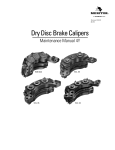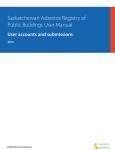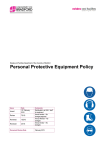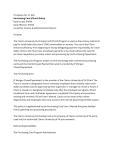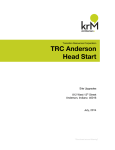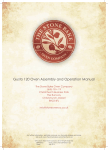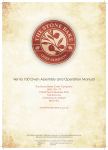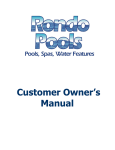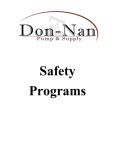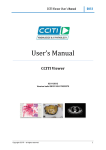Download Risks to your breathing
Transcript
Hazardous substances What should I know? Using hazardous substances at work can put your employees’ health at risk. Therefore, the Control of Substances Hazardous to Health Regulations (COSHH) place duties on you to take measures to prevent or control the exposure. Hazardous substances include: »chemical products used or produced at work (e.g. adhesives, cleaning agents) »substances generated by work (e.g. soldering or welding fumes, wood dust) »natural substances (e.g. grain, flour and enzyme dusts) »biological agents (e.g. fungi, bacteria, viruses). Hazardous substances can be present in your workplace as: »dust, powder or paste (e.g. wood, cement, metal, flour, grain, rubber or stone dust) »spray or mist (e.g. paint and epoxy sprays, acid mists) 9 »fumes (e.g. welding, hot rubber, soldering, galvanising fumes) »liquid (e.g. degreasing solvent, cleaning chemicals) »vapour (e.g. solvent vapour released from adhesives, paints, inks) »gas (e.g. chlorine, carbon monoxide). Employees can be exposed to hazardous substances by: »breathing them in »skin contact »swallowing »eye contact. Health effects of exposure to hazardous substances can include: »lung diseases (e.g. asthma, airway obstruction, bronchitis, lung cancers) »skin diseases (e.g. dermatitis, skin cancers, burns) »diseases of other organs (e.g. cancer in other parts of the body, nervous system diseases and disorders of reproductive organs) »damage to eyes. Rapid Reference Card Risks to your breathing Business effects of ill health caused by hazardous substances can include: »sickness absence and loss of productivity »enforcement actions, including court cases »increases in liability insurance premium »fines »compensation claims »loss of business. 11 Where can I get help? »Scottish Centre for Healthy Working Lives, tel: 0800 019 2211 or www.healthyworkinglives.com »Health and Safety Executive, www.hse.gov.uk/coshh For further details see ‘Where to get extra help and support’ on pages 83–88. What should I do? »Comply with the requirements of the COSHH Regulations. What should I avoid? »Creating dust, spray, mist, fumes, smoke, gases, vapours or solvent splashes without controlling the exposure. Additional information Requirements of COSHH include the following: You must not carry out any work which could expose your employees to hazardous substances without first: »considering the risks to health »identifying whether the exposure could be prevented »identifying the necessary exposure control measures, if exposure cannot be prevented »implementing the necessary control measures, including those required in the event of an emergency. What should I do to comply with COSHH? 1. Know the hazards: »Does any product you use have a danger label or sign? »Does it have a safety data sheet (SDS) or warnings? »Does your trade association or trade magazine have safety information on products or processes you use? Rapid Reference Card »When using a hazardous substance, does it give off dust, mist, spray, splashes, fumes, smoke, or gases? »Does anyone come into contact with the substance by touch, breathing it in or ingesting it? 2. Assess the risks and identify control measures. Determine the following: »Who is exposed and to what substance? »How is the exposure taking place (breathing in, skin contact, eye contact, ingestion)? »How much of the substance is the person exposed to, how often and for how long? »Why is the exposure taking place? »Does any employee have a preexisting health condition (e.g. asthma, dermatitis) that could affect this exposure? To make your assessment and to identify control measures that match your level of risk, you can use ‘COSHH Essentials’, www.coshh-essentials.org.uk/ Rapid Reference Card Damage to the airways and lungs Risks to your breathing 3. Choose control measures, in the following order: 1.Eliminate the use of a substance, or use a safer one. 2.Use a safer form of the substance, e.g. a paste rather than a powder. 3.Change the process to emit less of the substance. 4.Enclose the process so that the substance does not escape. 5.Extract emissions from the substance near the source. 6.Have as few workers in harm’s way as possible. 7.Provide personal protective equipment (PPE), e.g. gloves, coveralls, respirator. PPE must fit the wearer, and be the right type for the task, the substance and the work environment. If your control measures include items 5, 6 and 7, make sure they all work together. 4. Ensure control measures are used properly and maintained: »Train and instruct your workers to use control measures correctly. »Even the best control systems fail when they aren’t used in the right way. »Follow the recommended schedules for checking, maintenance and testing. »Keep records of checks and maintenance in logbooks. What should I know? Using hazardous substances at work can put your employees’ health at risk. Therefore, the Control of Substances Hazardous to Health Regulations (COSHH) place duties on you to take measures to prevent or control the exposure. 5. Prepare for emergencies: »Plan how to deal with accidents such as spills, and emergencies such as splashes on skin or in the eye, or unconsciousness. Breathing in too much of a hazardous substance (e.g. chemicals, some natural substances and materials) at work can cause: »asthma and other allergic reactions »other diseases of the airways and lungs (e.g. bronchitis) »lung and other cancers. 6. Monitor exposure and health: »Carry out exposure monitoring (air or biological samples such as breath or urine) where you need to ensure that control measures you put in place remain effective. »Carry out health checks (e.g. lung conditions, skin checks for dermatitis) if your trade press or HSE information shows there is a need, or one or more employees have reported or shown signs of health problems. This is not a full list. Rapid Reference Card The signs, symptoms and effects of the damage can include: »shortness of breath, wheezing, a tight feeling in the chest »persistent chesty cough and phlegm, troublesome chest infections »difficulty with climbing stairs, playing sport and taking part in other leisure activities »sickness absence and loss of productivity 13 »fatalities »enforcement action, court cases, compensation claims. The damage is caused by: »dusts, fumes, smoke, vapours, gases, mists, sprays » exposure over months and years »one or more sudden large exposures. Am I at risk? You, your business or staff may be put at risk, if: »you use substances labelled as Irritant, Corrosive, Harmful, Toxic, or Very Toxic »exposure to dusts, fumes, smoke, vapours, gases, mists, sprays is not controlled in some way »excessive dust and product residues (e.g. pastes, inks) are present on work surfaces, walls, floors and ventilation ducts »workers complain about irritation of eyes and airways »any of your employees have pre-existing health conditions (e.g. asthma). Rapid Reference Card Risks to your breathing What should I do? Identify the following: »Activities that produce dust, fumes, smoke, vapour, gas, mist or spray. »Who is exposed, why and to what level. »What preventive or control measures are needed and put them in place. »Who needs respirators, what type and face fit. »Is there a need to control skin exposure? »Who needs lung and airway health checks. Ensure the control measures you provide are used correctly and maintained. Consult employees or their representatives on matters affecting their health and safety. 15 What should I avoid? »Creating dust, spray, smoke, fumes, gas, mist, vapour, splashes, etc. without controlling the exposure. »Using an extraction system (LEV) which is not designed professionally, maintained and tested, or which is damaged. »Home-made modifications to LEV. »Using brooms, brushes or compressed air to clean dust on surfaces. »Incorrect selection, fitting or use of respirators. »Contaminated overalls causing exposure to the employee and their family. Where can I get help? »Scottish Centre for Healthy Working Lives, tel: 0800 019 2211 or www.healthyworkinglives.com »Health and Safety Executive, www.hse.gov.uk/coshh For further details see ‘Where to get extra help and support’ on pages 83–88. Rapid Reference Card Additional information Actions to prevent damage to breathing and lungs 1. Know the hazards: »Does any product you use have a danger label or sign? Does it have a safety data sheet (SDS) or warnings? »Does your trade association or magazine have safety information on products or processes you use? »When using the substance or product, does it give off dust, mist, spray, splashes, smoke, fumes, or gases? 2. Assess the risks and identify control measures: »Who is exposed, to what substances, in what form (e.g. gas, dust)? »How much of the substance is the person exposed to, how often and for how long? »Why is the exposure taking place? 3. Choose control measures in the following order: 1Eliminate the use of a substance, or use a safer one. 2Use a safer form of the substance, e.g. a paste rather than a powder. 3Change the process to emit less of the substance. 4Enclose the process so that the substance does not escape. 5Extract emissions from the substance near the source. 6Have as few workers in harm’s way as possible. 7Provide personal protective equipment (PPE), e.g. gloves, coveralls, respirator. PPE must fit the wearer, and be the right type for the task, the substance and the work environment. If your control measures include items 5, 6 and 7, make sure they all work together. Control measures should be selected or designed by competent people who are experienced in this area. Rapid Reference Card Local exhaust ventilation (LEV) Risks to your breathing 4. Ensure control measures are used properly and maintained: »Train and instruct your workers to use control measures correctly. »Even the best control systems fail if they are not used in the right way. »Follow the recommended schedules for checking, maintenance and testing. »Keep records of checks and maintenance in logbooks. 5. Prepare for emergencies: »Plan how to deal with accidents (e.g. spills). »Plan how to deal with emergencies (e.g. splashes on the skin or in the eye, or unconsciousness). 6. Monitor exposure and health: »Carry out exposure monitoring (air or biological samples such as breath or urine) where you need to ensure that control measures you put in place remain effective. »Carry out health checks (e.g. lung conditions) if your trade press or HSE information shows there is a need, or one or more employees have reported or shown signs of health problems. This is not a full list. What should I know? LEV is an engineering control system for extracting hazardous substances from the air before your employees can breathe them in. However, many LEV systems are not designed, installed, used, maintained or tested properly. These failures can cause workers to breathe in too much dust, fumes, gas, smoke, mist, vapour and/or spray at work, which can cause: »lung and airways diseases (e.g. asthma, cancers) »diseases in other parts of the body (e.g. heart, kidneys, reproductive system, skin). 17 The signs, symptoms and effects of disease can include: »shortness of breath, wheezing, a tight feeling in the chest »persistent chesty cough and phlegm, troublesome chest infections »difficulty with climbing stairs, playing sport and taking part in other leisure activities »sickness absence and loss of productivity »fatalities »enforcement action, court cases, compensation claims. Am I at risk? You, your business and employees may be at risk, if: »the LEV is not designed professionally »work is done too far away from the extraction capability (capture zone) of the LEV hood »the hood is not the right type »the LEV is damaged and not repaired »the compulsory annual test is not carried out to ensure correct working »fine dust layers are present on surfaces around LEV hoods. Rapid Reference Card Rapid Reference Card Risks to your breathing What should I do? »Work out which jobs and activities cause exposure. »Get the right type of LEV and install it correctly. »Get a user manual. »Train users in the correct use. »Carry out routine daily checks. »Maintain the LEV as recommended, and fill in the logbook. »Get it tested annually and display the test label. »Read the test report and carry out repairs promptly. »Consult workers or their representatives on matters affecting their health and safety. 19 Where can I get help? »Scottish Centre for Healthy Working Lives, tel: 0800 019 2211 or www.healthyworkinglives.com »Health and Safety Executive, www.hse.gov.uk/lev For further details see ‘Where to get extra help and support’ on pages 83–88. Additional information LEV can be used for extracting dust, fumes, vapour, gas, smoke, mist or spray. It usually has the following parts: »A hood, to collect contaminated air. »Ducting, to carry contaminated air. »A cleaner, to remove contaminant. »An air mover (fan), to draw the air through the system. »The air is then discharged to a safe place. What should I avoid? »Creating dust, spray, fumes, smoke, gas, mist, vapour or splashes without controlling the release at the point of production. »Home-made modifications to LEV. »Using damaged and unmaintained LEV. Rapid Reference Card When buying LEV: »Work out which jobs and activities require LEV. »What form is the contaminant (dust, fumes, vapour, gas, smoke, mist or spray or a combination of these)? »Know the properties of the contaminants (e.g. flammability, acidity, alkalinity, viscosity). »Write down the details of how the work is done. »Get a reputable supplier to advise you on the design. »Provide all necessary information and invite the supplier to observe the way the job will be done. »Involve LEV users in the discussion about design and specification. »The hood design should ensure that the work can be done within its extraction reach and capabilities. »Make sure the LEV is installed correctly. »Make sure commissioning is done and a report is provided. »Make sure the LEV has airflow indicators. »Make sure the LEV supplier provides a user manual and logbook. Rapid Reference Card Risks to your breathing Asbestos When using LEV: »Ask the supplier to train users in correct use. »Follow the instructions in the user manual. »Carry out daily checks, including the airflow indicators. »Check that the LEV is extracting hazardous substances. »If you move the hood or LEV, check that they are still working properly. »Check for any leaks through ducts, dampers and hoods. »Record faults in the logbook. »Get repairs done promptly and record them. »Get the LEV thoroughly examined and tested annually. »Do not use the LEV if it has a ’red label‘. Get the faults rectified promptly. »Manage and supervise the use of LEV. What should I know? Asbestos is still present in many buildings. It can be found in commercial properties, houses and other premises such as barns, churches and railway sheds. When asbestos-containing materials are damaged or disturbed, they can release dangerous invisible fibres. If these are breathed in, they can put your and your employees’ health at risk. Many tradesmen die from asbestos-related diseases. Workers who are most likely to be exposed to asbestos-containing materials are those in construction, maintenance, refurbishment and related trades. These include electricians, plumbers, heating and ventilation engineers, joiners and plasterers. This is not a full list. Rapid Reference Card 21 Diseases caused by asbestos fibres can include: »a cancer of the linings of the lungs and stomach, known as mesothelioma »lung cancer »scarring of the lungs, known as asbestosis »thickening of the lung walls, known as diffuse pleural thickening. These diseases take 15 to 60 years to develop. They are incurable and often fatal. The signs, symptoms and effects of the damage can include: »shortness of breath, wheezing, a tight feeling in the chest, even painful breathing »persistent chesty cough and phlegm, often painful, recurrent troublesome chest infections »difficulty with climbing stairs, playing sport and taking part in other leisure activities »weight loss »sickness absence and loss of productivity »fatalities. Rapid Reference Card Risks to your breathing Effects on business can include: »sickness absence »loss of productivity »loss of experienced staff »enforcement action, court cases, compensation claims. Am I at risk? You, your business or your staff may be put at risk, if: »you undertake work on a building which was constructed or refurbished before the year 2000 »you are working on an unfamiliar site »you don’t know how to work safely with asbestos-containing materials or products »your work causes any disturbance or damage to asbestos-containing materials »exposure to asbestos dust is not prevented or controlled in some way »any of your employees has a pre-existing health condition (e.g. asthma). 23 What should I do? »Before work commences, ask the customer or owner of a building to tell you whether there is evidence of asbestos-containing material. »Avoid working with asbestos if possible. »If you have to work on asbestoscontaining material, identify who will be exposed, and to what level. »Establish what preventive or control measures are needed and put them in place. »Train your staff to work with asbestos. »Identify who needs respirators and what types; provide proper fitting, training and instruction. »Provide lung and airway health checks. »Ensure the control measures you provide are used correctly and maintained. »Consult employees or their representatives on matters affecting their health and safety. Rapid Reference Card What should I avoid? »Working on asbestos material if it is a sprayed coating, board or lagging on pipes and boilers. Only a licensed contractor should work on these. »Using methods that generate asbestos dust (e.g. using power tools). »Sweeping up dust with brooms and brushes. »Using compressed air to clean dust on surfaces. »Incorrect selection, fitting or use of respirators. »Reusing disposable clothing or masks. »Taking used overalls home. Contaminated overalls can cause exposure to the employee and their family. Where can I get help? »Scottish Centre for Healthy Working Lives, tel: 0800 019 2211 or www.healthyworkinglives.com »Health and Safety Executive, www.hse.gov.uk/asbestos For further details see ‘Where to get extra help and support’ on pages 83–88. Rapid Reference Card Risks to your breathing Additional information Where are you likely to find asbestos? Buildings that were constructed or refurbished before the year 2000. Areas likely to contain asbestos materials include: »ceiling tiles »textured coatings on ceilings, walls and stairwells »sprayed coatings on ducts, pipes and some ceilings »boards around radiators, windows, fireplaces, building columns, pillars »inside fire doors »soffit boards »insulation on pipes »sealants on pipes joints, gaskets »ropes and yarns »fuse boxes »electrical switchgear »water tanks »cement products, roof sheets, downpipes. 25 Work safely with asbestos There are two types of asbestos-related tasks, namely asbestos licensed work and non-licensed tasks. However, you should note that if you are not licensed, you can still only work with non-licensed tasks after receiving training. This will help you to do the work safely. Examples of non-licensed tasks include work on: asbestos cement, textured coatings and asbestos cement roof and asbestos-containing gaskets, asbestos fabrics and asbestos insulating board (work taking less than an hour). There are many more tasks that fall into this category. If you are not sure, or require further information, consult the HSE’s Asbestos Essentials (www.hse. gov.uk/asbestosessentials). Rapid Reference Card Avoiding exposure »Avoid disturbing asbestos by doing the job in some other way, if possible. »Ensure the work you need to do does not require a licence. »Minimise dust by using hand tools. »Keep materials damp but not wet. »Clean up as you go using a Class H vacuum cleaner (high efficiency to minimise dust leakage through the cleaner). »Do not use a brush or broom. These create large amounts of invisible dust. »Wear a properly fitted and suitable respirator (e.g. disposable mask known as FFP3) and type 5 disposable coveralls. »When the work is finished, use either the H-class vacuum cleaner or a damp cloth to decontaminate your coveralls, gloves and the outsides of your mask. »Double-bag asbestos waste and label the bags with asbestos labels. Dispose of them at a permitted waste disposal site for asbestos. »Do not contaminate yourself when removing overalls and gloves. »Do not take overalls home. These can contaminate you and others at home. »Do not re-use disposable coveralls, dispose of them as asbestos waste. »Do not eat or drink in the work area. »Always ensure contaminated tools are cleaned with a damp cloth or use other ways to minimise dust creation. »Work in such a way to prevent contaminating work vans or your vehicle. Remember, smoking can seriously aggravate your health condition. This is not a full list. Rapid Reference Card Respiratory protective equipment (RPE) What should I know? RPE is designed to protect the wearer from hazardous substances in the air before they can breathe them in. RPE must be used where it is not possible to achieve adequate control of exposure by other control measures alone, and then only in addition to them. However, much of the RPE used at work is incorrectly selected, used, maintained or stored. These failures can cause workers to breathe in too much dust, fumes, smoke, gas, mist, vapour and/or spray at work. This can cause: »lung and airway diseases (e.g. asthma, cancers) »diseases in other parts of the body (e.g. heart, kidneys, reproductive system, skin). 27 The signs, symptoms and effects of disease can include: »shortness of breath, wheezing, a tight feeling in the chest »persistent chesty cough and phlegm, troublesome chest infections »difficulty with climbing stairs, playing sport and taking part in other leisure activities »sickness absence and loss of productivity »fatalities »enforcement action, court cases, compensation claims. Am I at risk? You, your business and staff may be at risk, if: »you use RPE as the main control without any consideration of other control measures »you do not know how to correctly select, use, maintain and store RPE »RPE masks are worn without fit testing »filters are not changed as recommended by the supplier »damaged or dirty RPE is used »RPE users are not trained in its correct use. Rapid Reference Card What should I do? »Work out which jobs and activities cause exposure and why RPE is needed. »Select the right RPE for the substance, task, wearer and environment. »Ensure other protective equipment used does not interfere with RPE use and performance. »Only use ‘CE’ marked RPE. »Carry out RPE fit testing for each wearer. »Use and maintain RPE as recommended by the manufacturer. »Train wearers in the correct use of RPE. »Mark the RPE zone in your premises. »Ensure the control measures you provide are used correctly and maintained. »Consult employees or their representatives on matters affecting their health and safety. What should I avoid? »Creating dust, spray, fumes, smoke, gas, mist, vapour, splashes without controlling the release at the point of production. »Incorrect selection, use, or storage of RPE. »Misuse of RPE. »Failure of employees to use RPE when required. »Home-made modifications to RPE. »Using damaged, dirty and unmaintained RPE. »Nuisance dust masks. Where can I get help? »Scottish Centre for Healthy Working Lives, tel: 0800 019 2211 or www.healthyworkinglives.com »Health and Safety Executive, www.hse.gov.uk/coshhessentials www.coshh-essentials.org.uk For further details see ‘Where to get extra help and support’ on pages 83–88. Rapid Reference Card Risks to your breathing Additional information There are two types of RPE. These are respirators and breathing apparatus. Respirators: »use filters to remove dust, sprays, mists, gases, fumes or vapours »must never be used in an area of low oxygen levels or very high contaminant levels. These situations are immediately dangerous to life or health. They are commonly found in confined spaces (e.g. chambers, tanks, vats, pits, trenches, pipes, sewers, flues or wells) »will not provide protection unless fitted with the right type or size of filters, which are changed as recommended. Breathing apparatus (BA): »uses breathing-quality air from a clean source such as an air cylinder or an air compressor and airlines hoses. BA may be used in confined spaces. 29 RPE may be used in the following circumstances: »As a last control measure after taking other control measures (e.g. dust, spray, vapour, mist suppression methods and extract ventilation). »For short-duration or infrequent work where control at source is not practical. »As a temporary measure before other controls are in place. »To escape in an emergency. »For emergency work – breakdowns, maintenance, spills. »For rescuing people in danger. »As an additional protection in case other control measures fail to operate. The ‘CE’ mark on RPE: »means RPE meets the minimum design and performance features as set out in law and international standards. »does not mean it is necessarily the right sort of RPE. You must select the right type for your own needs. Get help where necessary. Rapid Reference Card Selecting the right RPE Match it to the following: »Substance – dust, fumes, mist, spray, smoke, vapour and/or gas. »Task undertaken – e.g. heavy work, moving about, light work. »Wearer – e.g. face size and shape, beards, spectacles, turban. »Environment – e.g. hot or cold, confined space. »Other PPE used – e.g. hard hat, goggles. Provide training This will ensure: »correct use, maintenance and storage of RPE »correct techniques are used to carry out the work, and for using tools and equipment »wearers understand why they need to wearer the RPE provided. Common misuses of RPE include: »face masks used without fit testing »goggles or spectacles causing poor fit of face mask »nose bridge on RPE not pinched correctly »facial hair interfering with fit and protection »broken or damaged straps »using only one strap »twisting straps together »dirty and damaged face seals and valves »damaged face mask »missing components (e.g. valves, filters, straps) »DIY modifications »airflow not adjusted correctly. This is not a full list. Maintain, examine and test the RPE in accordance with the manufacturer’s instructions and at least once every month, and keep records. Rapid Reference Card Respiratory protective equipment (RPE) selection What should I know? RPE must be used where it is not possible to achieve adequate control of exposure by other control measures alone, and then only in addition to them. Other exposure control measures include: »eliminating the use of the toxic substance »replacing it with a low toxicity substance »modifying the way you do the job, using suitable handling methods, equipment, and/or tools »enclosing the process (so that hazardous substances do not escape into workplace air) »providing adequate local extraction ventilation »reducing the number of employees exposed to hazardous substances. When can I use RPE? »After using other control measures. »For short-duration or infrequent jobs where other controls may not be practicable. »When you are putting in place other control measures. »To escape in the event of an emergency (e.g. leaks). »Emergency repairs or work. »For rescuing someone in danger. In addition, you may consider issuing RPE to provide additional protection in case other control measures fail to operate. Am I at risk? You, your business and staff may be put at risk, if : »you use RPE as the main control without considering other control measures »you do not know how to correctly select, use, maintain and store RPE »RPE masks are worn without fit testing »filters are not changed as recommended by the supplier »damaged or dirty RPE is used Rapid Reference Card 31 »RPE users are not trained in its correct use. What should I do? »You may use the table on page 32– 33 or seek the help of a professional to select the right RPE. »If you use the table and you are unsure about or do not know answers to any of the issues contained in it, seek professional help. »Ask your RPE supplier to provide RPE options based on the information you supply. »Select the right RPE from the options available – it is your responsibility to do this. »Use RPE as recommended. »Train employees in the correct use and storage of RPE. »Maintain RPE as recommended. What should I avoid? »Creating dust, spray, fumes, smoke, gas, mist, vapour, splashes without controlling the release at the point of production. »Incorrect selection, use or storage of RPE. »Misuse of RPE. »Employees not wearing RPE when they should be doing so. »Home-made modifications to RPE. »Using damaged, dirty and unmaintained RPE. »Nuisance dust masks. Where can I get help? »Scottish Centre for Healthy Working Lives, tel: 0800 019 2211 or www.healthyworkinglives.com »Health and Safety Executive, www.hse.gov.uk/coshh-essentials. org.uk For further details see ‘Where to get extra help and support’ on pages 83–88. Rapid Reference Card Risks to your breathing 33 What you need to know to select the right RPE Task or job for which RPE is needed (e.g. paint spraying, cleaning, sawing, welding) Where is the work undertaken? (i)A confined space (e.g. a chamber, vat, tank, silo, pit, trench, sewer, flue, well) (ii)A space lacking oxygen (no free air exchange with outside air) (iii)Area with chances of sudden release of copious contaminants (iv)A flammable and/or explosive area Write task here: Yes No Unsure Yes No Unsure Yes No Unsure Yes No Unsure How long does the task take? (e.g. spraying a car, 20 minutes; welding a pipe, 10 minutes; cleaning a surface, 30 minutes; sanding a wood panel, 10 minutes; cutting stone, 5 minutes) Hours Minutes How long will the RPE be worn before it is taken off for a break or rest? Less than 1 hour More than 1 hour How many times a day is the task performed? times What is the total number of hours of RPE use each day? hours Light Medium Chemicals in products (get an up-to-date safety data sheet from your product supplier) or substances created at work (e.g. welding fumes, wood dust) or natural substances used (e.g. flour, hay dust) Write name of substance here: How much physical effort is needed to do the work? Light – seated Medium – sustained hand–arm work Heavy – heavy manual work (If you do not know or you are unsure, seek professional help) Is clear, precise verbal communication with others necessary to ensure safety and to give and receive instructions? Vital How much of the product is used each time? Handful Few Kg Tons Hot Cold What is the physical form of the product as supplied or used? Solid Gas Liquid Are other hazards associated with the task? Hot – above room temperature or direct sun Cold – around 15°C or below Humidity – higher than a normal work area If a solid, how dusty is the substance? High – fine powder/dust cloud in air Medium – crystalline materials Low – pellets, pill-like or waxy/sticky High Medium Low (If yes or unsure, seek professional help) Heavy Not necessary High Humidity Wind Work at different heights Move around obstacles (If do not know or you are unsure, seek professional help) Do any RPE wearers have: Water-based °C If liquid, what is its boiling point? Others What temperature is the product used at? Room Temperature Does the task or job create: (Mark all that apply and write down exact details of the type of gas, vapour, metal fumes, dust, mist, spray or smoke created) Gas Vapour Spray A A moustache Extended sideburns °C Metal fumes Does any wearer need: Dust Mist A beard Spectacles Earmuffs Helmet Important What size range is needed to meet the needs of all wearers? Smoke (If unsure, seek professional help) Rapid Reference Card Rapid Reference Card















